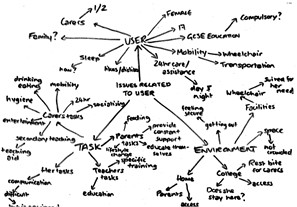Brainstorming is useful to help identify issues, which may then be placed within a context using a mind-map technique and a user, task and environment (UTE) as a starting point. An example of mind-mapping is shown. This can be good for a group discussion as talking aloud and writing down (externalising the issues) can trigger
Use paper, flip-chart or digital recording of an individual or group.
Key elements when applying this method include:
- Immediate ideas, (whatever comes into your mind whilst thinking about this problem).
- No qualifying or dismissal of ideas (at this stage)
- Quick realisation of problem and omissions in knowledge

Useful links
Torrens, GE (2011) Universal Design: empathy and affinity. In Karwowski, W, Soares, M, M, Stanton, A, N, Eds, (ed) Handbook of Human Factors and Ergonomics in Consumer Products, CRC Press, pp.233-248 Available at: (http://www.crcnetbase.com/doi/abs/10.1201/b10950-19), Accessed: [23/09/015]
Torrens, G.E., 2012. Assistive Technology product to Universal design: A way forward, Design For All India, 7 (7), pp.182-205 Available at: (https://dspace.lboro.ac.uk/dspace-jspui/handle/2134/15736), Accessed: [23/09/2015]
